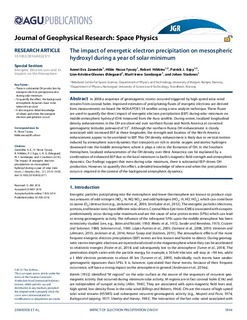| dc.contributor.author | Sandanger, M.I. | |
| dc.contributor.author | Tyssøy, Hilde Nesse | |
| dc.contributor.author | Hibbins, Robert Edward | |
| dc.contributor.author | Zawedde, A.E. | |
| dc.contributor.author | Stadsnes, Johan | |
| dc.contributor.author | Espy, Patrick Joseph | |
| dc.contributor.author | Ødegaard, L-K | |
| dc.date.accessioned | 2017-01-12T15:26:49Z | |
| dc.date.available | 2017-01-12T15:26:49Z | |
| dc.date.created | 2016-11-08T14:54:40Z | |
| dc.date.issued | 2016 | |
| dc.identifier.citation | Journal of Geophysical Research: Space Physics. 2016, 121(6), 5914–5929 | nb_NO |
| dc.identifier.issn | 2169-9380 | |
| dc.identifier.uri | http://hdl.handle.net/11250/2427169 | |
| dc.description.abstract | In 2008 a sequence of geomagnetic storms occurred triggered by high-speed solar wind streams from coronal holes. Improved estimates of precipitating fluxes of energetic electrons are derived from measurements on board the NOAA/POES 18 satellite using a new analysis technique. These fluxes are used to quantify the direct impact of energetic electron precipitation (EEP) during solar minimum on middle atmospheric hydroxyl (OH) measured from the Aura satellite. During winter, localized longitudinal density enhancements in the OH are observed over northern Russia and North America at corrected geomagnetic latitudes poleward of 55°. Although the northern Russia OH enhancement is closely associated with increased EEP at these longitudes, the strength and location of the North America enhancement appear to be unrelated to EEP. This OH density enhancement is likely due to vertical motion induced by atmospheric wave dynamics that transports air rich in atomic oxygen and atomic hydrogen downward into the middle atmosphere, where it plays a role in the formation of OH. In the Southern Hemisphere, localized enhancements of the OH density over West Antarctica can be explained by a combination of enhanced EEP due to the local minimum in Earth’s magnetic field strength and atmospheric dynamics. Our findings suggest that even during solar minimum, there is substantial EEP-driven OH production. However, to quantify this effect, a detailed knowledge of where and when the precipitation occurs is required in the context of the background atmospheric dynamics. | nb_NO |
| dc.language.iso | eng | nb_NO |
| dc.publisher | American Geophysical Union | nb_NO |
| dc.rights | Attribution-NonCommercial-NoDerivatives 4.0 Internasjonal | * |
| dc.rights | Attribution-NonCommercial-NoDerivatives 4.0 Internasjonal | * |
| dc.rights.uri | http://creativecommons.org/licenses/by-nc-nd/4.0/deed.no | * |
| dc.title | The impact of energetic electron precipitation on mesospheric hydroxyl during a year of solar minimum | nb_NO |
| dc.type | Journal article | nb_NO |
| dc.type | Peer reviewed | nb_NO |
| dc.source.pagenumber | 5914–5929 | nb_NO |
| dc.source.volume | 121 | nb_NO |
| dc.source.journal | Journal of Geophysical Research: Space Physics | nb_NO |
| dc.source.issue | 6 | nb_NO |
| dc.identifier.doi | 10.1002/2016JA022371 | |
| dc.identifier.cristin | 1398492 | |
| dc.relation.project | Norges forskningsråd: 223252/F50 | nb_NO |
| dc.description.localcode | ©2016. The Authors. This is an open access article under the terms of the Creative Commons Attribution-NonCommercial-NoDerivs License, which permits use and distribution in any medium, provided the original work is properly cited, the use is non-commercial and no modifications or adaptations are made. | nb_NO |
| cristin.unitcode | 194,66,20,0 | |
| cristin.unitname | Institutt for fysikk | |
| cristin.ispublished | true | |
| cristin.fulltext | original | |
| cristin.qualitycode | 2 | |

